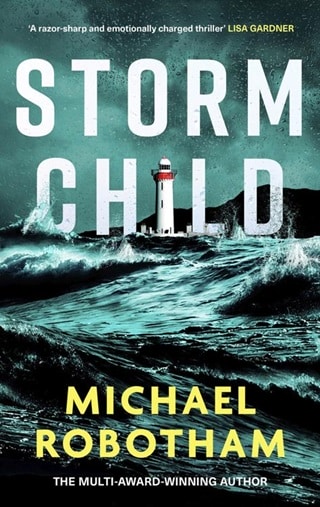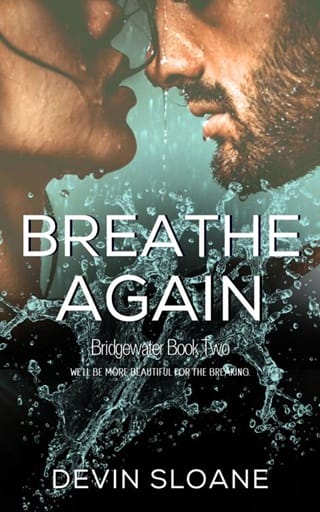18 Cyrus
18
The remains of the rigid-hulled inflatable boat are lying like a deflated whale on the concrete floor of the warehouse. The red and black fabric is torn in places, revealing the skeletal frame beneath the rubberised skin. Nearby, the engine and fuel tank have been placed on a wooden platform. The engine is clamped upright in a support frame, the upper casing removed, the workings exposed.
A technician in white overalls has climbed a ladder to take photographs of the RHIB from above. Another is measuring holes in the torn fabric, while a third is placing small evidence flags to indicate points of interest. She turns and acknowledges us, recognising Carlson. Smiling.
‘This is DC Gayle,' he says, making the introductions.
‘Call me Claire,' she says.
No handshakes. A gloved wave, instead. She's in her late thirties, with short-cropped blonde hair and inquisitive eyes.
‘What are you looking for?' I ask.
‘Point of impact, velocity, direction, size, yaw axis, supplementary damage . . .'
‘When you say supplementary damage?'
‘The RHIB was hit more than once.'
‘How many times?' asks Carlson.
‘Three times from different angles.'
She moves around the wreckage, pointing out tears in the fabric.
‘The damage was caused by propellers with four blades.'
‘How can you tell?' I ask.
‘The leading edge of each blade contacts the water first as the propeller spins. The trailing edge contacts the water last as it rotates. That's why trawler props tend to be rounded or half-oval shapes. The damage has parallel tracks, indicating twin propellers.'
‘How big was the boat?' asks Carlson.
‘A twin-screw vessel with counter-rotating propellers twenty-five inches in diameter with a thirty-two-inch pitch – suggests something about sixty feet long.'
‘A fishing trawler.'
‘That would fit,' she says.
DC Gayle steps away from the RHIB and pulls off her latex gloves.
She continues. ‘A typical four-blade propeller can spin at anywhere from one thousand two hundred to three thousand two hundred RPMs, depending on the engine horsepower. A spinning blade will hit a body about a hundred and sixty times a second, causing horrific injuries. You also have the hydrodynamic effect. Propellers create a suction that can easily pull a full-sized person under a boat. When that happens, the impact to a body, head to toe, takes about a tenth of a second, and is normally fatal.'
‘That fits with some of the injuries we found,' says Carlson.
Gayle has walked several paces to point out more damage. ‘The original impact destroyed two of the air chambers on the starboard side. The second impact destroyed another air chamber and briefly submerged the RHIB. We have found traces of boat paint on the rubberised fabric and evidence that the bigger vessel's prop shaft may have been damaged.'
‘How badly damaged?' asks Carlson.
‘Difficult to say, sir.'
Carlson's phone is buzzing. He steps away to take the call. Soon afterwards, I'm summoned to follow. He walks and talks. ‘HM Coastguard has plotted a possible point of collision. They're sending someone from their joint operations centre to talk to us.'
I ride in the police car with Carlson. He answers calls on the journey, receiving information about the post-mortems and the ongoing investigation. Twelve of the dead have been identified.
When his next call ends, he turns to me. ‘You haven't given me your opinion.'
‘On what?'
‘You're my fresh set of eyes. What am I dealing with?'
‘Not an accident.'
‘Clearly.'
‘It's either a random racist act or part of an orchestrated campaign to discourage migrants from making the crossing.'
‘What makes you think it's orchestrated?'
‘This boat separated from the other migrant vessel that left Calais on the same evening. It went north-east, along the French coast, before turning north-west. This made the journey longer and riskier. Why?'
‘I assume you're going to tell me.'
‘They were frightened because they didn't have permission to travel.'
‘Permission from who?'
‘The migrants call him the Ferryman. The National Crime Agency calls him a myth. I talked to a friend at the NCA, who said rival gangs of people smugglers have been waging a turf war over the past year – trying to control the people trade. This sinking could have been a warning – telling migrants to choose the right side.'
Carlson seems to chew this information over, as we enter the outskirts of Grimsby. ‘Go back to the racist angle.'
‘Have you heard of the Identitarian movement?' I ask.
‘No.'
‘It's a political ideology that opposes globalisation and multiculturalism. Basically, they're a bunch of white Europeans who claim their land and their culture is being polluted by foreigners. One group, Defend Europe, has been leasing ships and leading patrols in the Mediterranean.'
‘What sort of patrols?'
‘Publicly, they claim to be monitoring the humanitarian ships who are picking up refugees, but privately there are reports of migrant boats being deliberately swamped or made to turn back to North Africa.'
‘Vigilantes?'
‘Not a word they use.'
‘You think a group like that could be operating in UK waters?'
‘I think it's worth investigating.'
‘Surely such a group would claim responsibility for the sinking – otherwise it won't be a deterrent.'
‘Maybe they have. The information only has to reach the camps. That's their audience.'
‘So, we should be looking at white nationalists or neo-Nazis?'
‘Particularly anyone with a history of violence against migrants or minorities. Most are recruited when they're young. The unemployed and unemployable. The bullied and marginalised.'
‘You sound like you know them?'
‘Men like that, yes.'
‘What about the missing women?'
‘If they're alive, they were most likely taken on board the trawler because they had value.'
Carlson knows the reason. Hundreds, if not thousands, of undocumented migrants are kept as sex slaves in British brothels; exploited, imprisoned, beaten, drugged, and threatened. They're told their families back home will be killed if they refuse to obey orders.
One of them, a patient of mine, was only seventeen when she escaped. She had worked twenty-hour shifts in a Soho brothel in London, forced to have sex with up to forty men a day for as little as £10 a time. She was told she had to pay off a £20,000 debt, which was the price the brothel had paid for her.
‘We have to find them quickly,' I say.
‘I'm doing my best.'
Birchin Way Custody Facility is built on the edge of an industrial estate and looks like a cross between a high-tech production facility and a business headquarters. The only clues to its use are the police cars parked out front and an automatic security gate signposted ‘Custody Entrance'.
‘State-of-the-art,' says Carlson. ‘Thirty-six custody cells, charge rooms, interview suites and round-the-clock processing. This is supposed to be the future.'
‘Does it work?'
‘As much as anything will.'
I'm photographed and given an electronic pass before being taken upstairs to the incident room – an open-plan office where detectives, civilian analysts and data processors are collecting and collating information. Whiteboards display photographs of the dead, whose personal details are slowly being filled in – ages, nationalities and next of kin.
The coastguard official is waiting in Carlson's office. He's in his mid-fifties with a weather-beaten face and pale circles around his eyes caused by his sunglasses.
‘Commander Greg Stanford,' he says, standing to attention. ‘I was the senior operations officer who handled the search and rescue.'
I don't know if I should salute or shake his hand.
Stanford has set up a laptop and a viewing screen. ‘This is what we've pieced together so far,' he says, calling up an interactive map of the French coastline. ‘Two small boats left Calais shortly after 2100 hours. The seas were calm, visibility good. They separated almost immediately and one went north-east, following the coastline as far as Rotterdam, before turning north-west.'
His finger traces the route on the screen.
‘How can you be sure?' I ask.
‘Large ships carry professional radar, which can reach up to four miles. This can be limited by fog and rain but is reasonably accurate. A rigid-hulled inflatable boat is not a strong target because it doesn't have radar reflectors, but it can become more visible in larger swells due to refraction.'
Stanford calls up a satellite map and points to an icon.
‘We think this is the migrant boat. It was picked up by the radar on a container ship that was travelling from Harwich to Zeebrugge in Belgium. A different ship picked up a similar signature two hours later, about thirty-five miles further north.'
The screen changes again, this time showing a neon green flight path. ‘These are radar images captured by a UR5 drone used for border surveillance. It was airborne at 240 metres at 05.19.'
The footage speeds up but slows down when it reaches a chosen time stamp.
‘What am I looking at?' I ask.
‘These two blips indicate two vessels, one larger than the other. They appear to almost merge before one of them disappears.' ‘A collision,' says Carlson.
‘Unless the larger boat began towing the smaller one. We estimate the collision occurred sixteen miles north-east of Skegness, east of Mablethorpe, at approximately 05.32 hours. The bodies drifted north-east, pushed by the currents and wind, before coming ashore at Cleethorpes.'
‘What vessels were in the area?' asks Carlson.
Stanford calls up another screen. ‘This is a maritime traffic map for that quadrant. It doesn't show either boat because neither was using an automatic identification system, which transmits location signals to satellites. A trawler should have been equipped with an AIS, but it was likely turned off.'
‘Can you track it using the radar of other ships in the vicinity?' I ask.
‘The drone was only overhead for nine minutes, but we're searching the radar signals of other ships in the area, trying to get a fix on where the larger vessel went after the collision. To date, our best lead has come from the local harbour master here in Grimsby. On Monday morning, a support tender for one of the wind farm operations reported a near collision with an unmarked trawler as it passed Spurn Head. The tender radioed the unidentified boat but got no response.'
‘Where is Spurn Head?' I ask.
‘The narrowest point that boats enter the Humber estuary,' says Stanford. ‘The tender skipper thought the boat was making an awful racket, possibly from a damaged prop shaft.'
‘Where would it go?' asks Carlson.
‘The Humber estuary covers more than a hundred square miles. There are dozens of marinas and boatyards. A hundred places to hide.'
Carlson isn't fazed. ‘Well, we'd best get started.'
 Fullepub
Fullepub 



